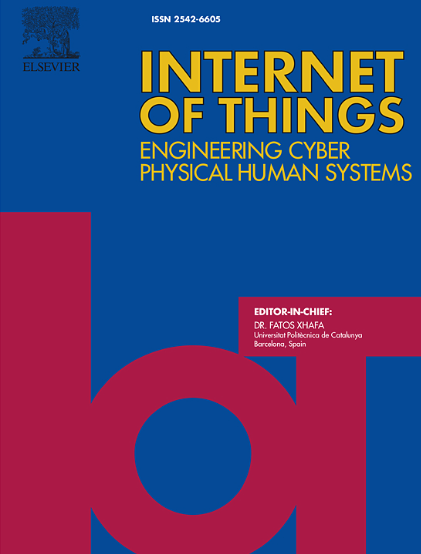Fingerprinting chipless RFID with a MIMO system for tag authentication in Internet of Things
IF 6
3区 计算机科学
Q1 COMPUTER SCIENCE, INFORMATION SYSTEMS
引用次数: 0
Abstract
This paper presents a new method to tackle the security issues of chipless tag systems in Internet of Things (IoT) applications. The strategy aims to prevent the cloning of tags by utilizing the intrinsic natural randomness in the manufacturing process. This research presents a novel approach to generate fingerprints for chipless Radio Frequency Identification (RFID) tags using the unique backscattered electromagnetic (EM) responses, caused by inherent natural variations in resonator geometry, captured by a portable Multiple Input Multiple Output (MIMO) reader. Using twenty-two tags, one authentic and twenty-one counterfeits, two separate sets of fingerprints were generated using both Frequency Domain (FD) and Time Domain (TD) data, respectively. The clone detection model achieved an accuracy of 98.41% in a 35 dB noisy environment using fingerprints generated from FD data and 92.07% in a 50 dB noisy environment using fingerprints derived from TD data. This was obtained by utilizing similarity metrics such as Mean Squared Error (MSE) and Structural Similarity Index (SSI), offering a robust alternative to traditional tag authentication methods. The portability and affordability of the MIMO reader, combined with new opportunities for image-based identification, position this approach as a substantial advancement in the realm of authenticity verification for chipless RFID tags in the realm of IoT.

基于MIMO系统的无芯片RFID指纹识别技术在物联网中的应用
本文提出了一种解决物联网(IoT)应用中无芯片标签系统安全问题的新方法。该策略旨在利用制造过程中固有的自然随机性来防止标签的克隆。本研究提出了一种利用独特的反向散射电磁(EM)响应为无芯片射频识别(RFID)标签生成指纹的新方法,该响应是由谐振器几何形状固有的自然变化引起的,由便携式多输入多输出(MIMO)读取器捕获。使用22个标签,一个真品和21个伪造品,分别使用频域(FD)和时域(TD)数据生成两组不同的指纹。克隆检测模型在FD数据产生的指纹噪声为35 dB的环境下准确率为98.41%,在TD数据产生的指纹噪声为50 dB的环境下准确率为92.07%。这是通过利用均方误差(MSE)和结构相似指数(SSI)等相似性指标获得的,为传统的标签认证方法提供了一种强大的替代方案。MIMO读取器的便携性和可负担性,加上基于图像识别的新机会,使这种方法成为物联网领域无芯片RFID标签真实性验证领域的重大进步。
本文章由计算机程序翻译,如有差异,请以英文原文为准。
求助全文
约1分钟内获得全文
求助全文
来源期刊

Internet of Things
Multiple-
CiteScore
3.60
自引率
5.10%
发文量
115
审稿时长
37 days
期刊介绍:
Internet of Things; Engineering Cyber Physical Human Systems is a comprehensive journal encouraging cross collaboration between researchers, engineers and practitioners in the field of IoT & Cyber Physical Human Systems. The journal offers a unique platform to exchange scientific information on the entire breadth of technology, science, and societal applications of the IoT.
The journal will place a high priority on timely publication, and provide a home for high quality.
Furthermore, IOT is interested in publishing topical Special Issues on any aspect of IOT.
 求助内容:
求助内容: 应助结果提醒方式:
应助结果提醒方式:


